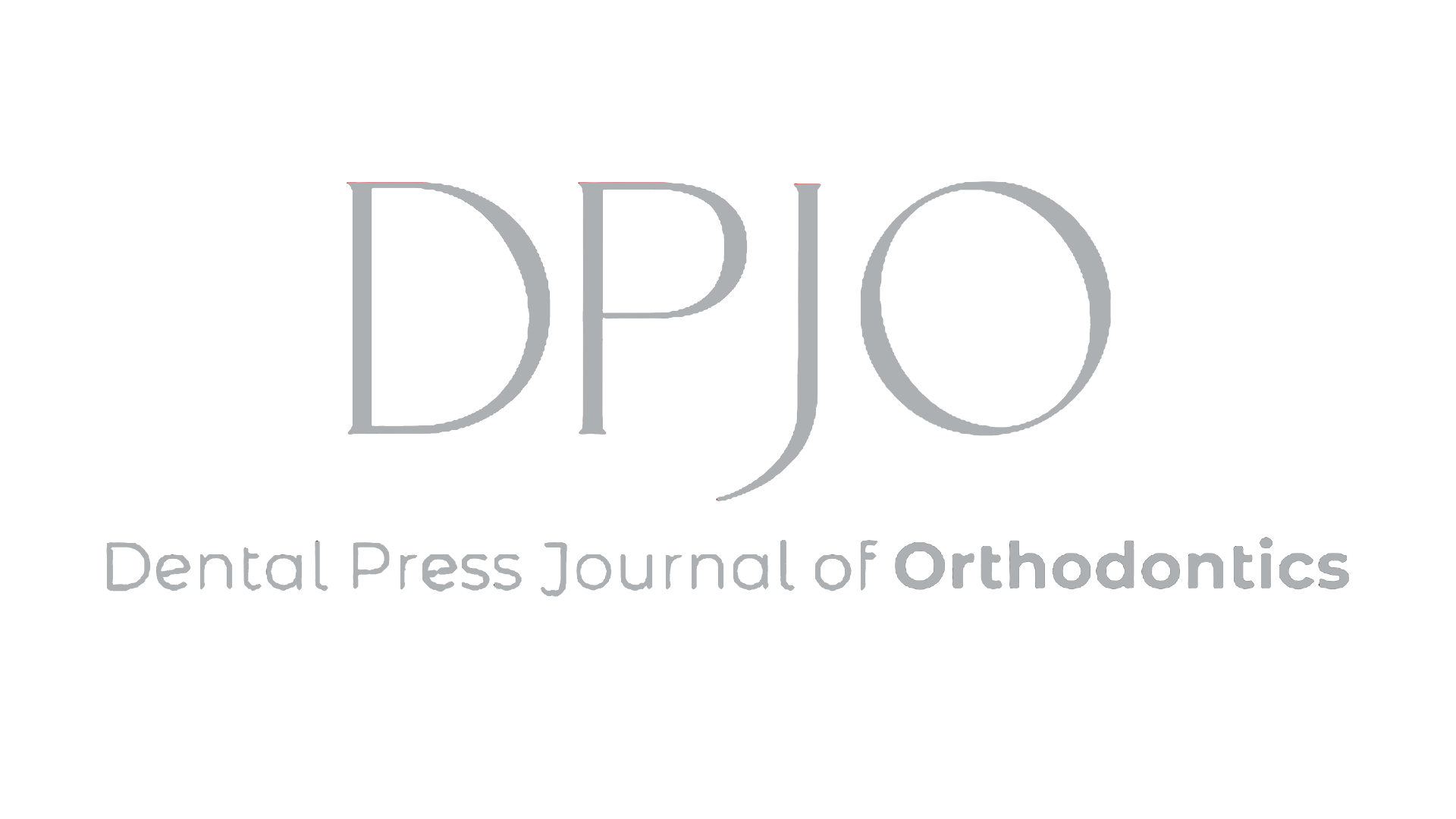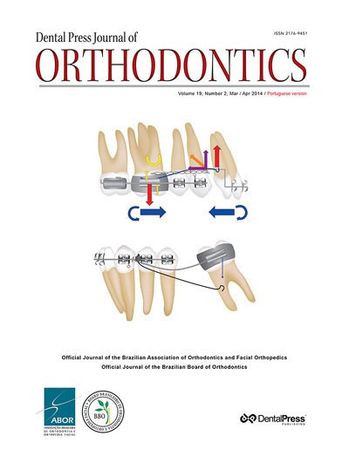The Brazilian dental science
Three years ago, a sublime editorial1 praised the audacious growth of Brazilian dental scientific production. At that time, our former editor dared to foresee the position Brazil would occupy in 2015: the most productive country in terms of dental scientific knowledge. The author was based on...
Autores: David Normando,
messages.RevistaAutores:
LEIA MAIS
orthodontics highlights
The early treatment of Class III malocclusion is a challenge for orthodontists around the world. The challenges imposed by Biology are associated with the difficulty to obtain patient’s adhesion to traditional methods of treatment: maxillary disjunction followed by maxillary protraction with...
Autores: Matheus Melo Pithon,
messages.RevistaAutores:
LEIA MAIS
Reasons for mini-implants failure: choosing installation site should be valued!
Mini-implant loss is often associated with physical and mechanical aspects that result from choosing an inappropriate placement site. It is worth highlighting that: a) Interdental alveolar bone crests are flexible and deformable. For this reason, they may not offer the ideal absolute anchorage....
Autores: Alberto Consolaro, Fábio Lourenço Romano,
messages.RevistaAutores: Mini-implants, Temporary anchorage devices, Micro-screws, Mini-implants. Absolute anchorage,
LEIA MAIS
Error of the method: what is it for?
The aim of this paper is to demonstrate the importance of evaluating the error of the method in Orthodontic scientific studies. Special emphasis will be given to the scientific importance and the different types of the error of the method (systematic and casual), the statistical tests most...
Autores: Rodrigo Hermont Cançado, José Roberto Pereira Lauris,
messages.RevistaAutores:
LEIA MAIS
An interview with Marissa C. Keesler
Dr. Marissa Keesler attended dental school at Creighton University in Omaha, Nebraska and in 1987 received her Doctor of Dental Surgery degree with high honors. In 1989, she graduated from Marquette University with a Certificate and Master of Science degree in Orthodontics. Dr. Keesler has been...
Autores: Fernanda Catharino, Nelson Mucha, Luciana Q. Closs, Roberto Lima,
messages.RevistaAutores:
LEIA MAIS
Transverse effect of Haas and Hyrax appliances on the upper dental arch in patients with unilateral complete cleft lip and palate: A comparative study
Objective: The aim of the present study was to evaluate the transverse effect of rapid maxillary expansion in patients with unilateral complete cleft lip and palate while comparing the Haas and Hyrax appliances. Methods: The sample consisted of 48 patients divided into two groups: Group I – 25...
Autores: Omar Gabriel Da Silva Filho, Tulio Silva Lara, Daniela Gamba Garib, Anna Júlia De Oliveira Façanha,
messages.RevistaAutores: Cleft palate, Dental arch, Palatine expansion technique,
LEIA MAIS
The influence of orthodontic fixed appliances on the oral microbiota: A systematic review
Objective: To investigate whether there is scientific evidence to support the hypothesis that the presence of orthodontic fixed appliances influences the oral microbiota. Methods: The search for articles was conducted in PubMed; ISI Web of Knowledge and Ovid databases, including articles...
Autores: Matilde Da Cunha Gonçalves Nojima, Mariana Marquezan, Lucianne Cople Maia, Amanda Osório Ayres De Freitas, Daniela Sales Alviano,
messages.RevistaAutores: Orthodontic appliances, Periodontics, Attachment sites, Microbiological, Microbiological analysis,
LEIA MAIS
Bibliometric analysis of scientific articles published in Brazilian and international orthodontic journals over a 10-year period
Objective: This study aimed at describing the profiles of Brazilian and international studies published in orthodontic journals. Methods: The sample comprised 635 articles selected from two scientific journals, i.e., Dental Press Journal of Orthodontics and American Journal of Orthodontics and...
Autores: Maximiano Ferreira Tovo, Neudí Antonio Primo, Vivian Bertoglio Gazzola, Bruno Tochetto Primo, Italo Medeiros Faraco Junior,
messages.RevistaAutores: Orthodontics, Dental research, Bibliometrics, Study characteristics,
LEIA MAIS
Photometric analysis of esthetically pleasant and unpleasant facial profile
Objective: To identify which linear, angular and proportionality measures could influence a profile to be considered esthetically pleasant or unpleasant, and to assess sexual dimorphism. Methods: 150 standardized facial profile photographs of dental students of both sexes were obtained and...
Autores: Edgard Norões Rodrigues Da Matta, Helena Nunes Da Rocha Fortes, Thamirys Correia Guimarães, Ivana Mara Lira Belo,
messages.RevistaAutores: Esthetics, Orthodontics, Photography,
LEIA MAIS
Comparison of topical and infiltration anesthesia for orthodontic mini-implant placement
Objective: To compare the acceptability and effectiveness of topical and infiltration anesthesia for placement of miniimplants used as temporary anchorage devices. Methods: The sample comprised 40 patients, 17 males and 23 females, whose mean age was 26 years old and who were all undergoing...
Autores: Fabrício Pinelli Valarelli, Rodrigo Hermont Cançado, Matheus Miotello Valieri, Karina Maria Salvatore De Freitas,
messages.RevistaAutores: Orthodontic Anchorage Procedures, Orthodontics, Dental implants, Anesthetics,
LEIA MAIS
Evaluation of a photographic method to measure dental angulation
Objective: To analyze the reliability and reproducibility of a simplified method for analysis of dental angulation using digital photos of plaster dental casts. Methods: Digital and standardized photographs of plaster casts were performed and posteriorly imported to an angle reading graphic...
Autores: David Normando, Jordana Rodrigues Amorim, Diogo De Vasconcelos Macedo,
messages.RevistaAutores: Dental crown, Dental photography, Evaluation,
LEIA MAIS
Reliability of CBCT in the diagnosis of dental asymmetry
Objective: The aim of this study was to validate a method used to assess dental asymmetry, in relation to the skeletal midline, by means of CBCT. Methods: Ten patients who had CBCT scans taken were randomly selected for this study. Five different observers repeated 10 landmarks (x, y and z...
Autores: Antônio Carlos De Oliveira Ruellas, Carolina Baratieri, Matheus Alves Junior, Claudia Trindade Mattos, Leonardo Koerich, Daniel Brunetto, Lindsey Eidson,
messages.RevistaAutores: imaging, Dental arch, cone-beam computed tomography, Three-dimensional diagnosis,
LEIA MAIS
Nicotine effect on bone remodeling during orthodontic tooth movement: Histological study in rats
Introduction: Nicotine is harmful to angiogenesis, osteogenesis and synthesis of collagen. Objective: The aim of this study was to investigate the effect of nicotine on bone remodeling during orthodontic movement in rats. Methods: Eighty male Wistar rats were randomly divided into three groups:...
Autores: Hiroshi Maruo, Orlando Motohiro Tanaka, Ricardo Lima Shintcovsk, Luégya Knop,
messages.RevistaAutores: Tooth movement, Bone resorption, Bone formation, Blood vessels, Nicotine,
LEIA MAIS
Corrosion behavior of self-ligating and conventional metal brackets
Objective: To test the null hypothesis that the aging process in self-ligating brackets is not higher than in conventional brackets. Methods: Twenty-five conventional (GN-3M/Unitek; GE-GAC; VE-Aditek) and 25 self-ligating (SCs-3M/Unitek; INs-GAC; ECs-Aditek) metal brackets from three manufacturers...
Autores: Antônio Carlos De Oliveira Ruellas, Mônica Tirre De Souza Araújo, Delmo Santiago Vaitsman, Lúcio Henrique Esmeraldo Gurgel Maia, Hibernon Lopes Filho,
messages.RevistaAutores: metal, Orthodontic brackets, Corrosion,
LEIA MAIS
Class I malocclusion with anterior crossbite and severe crowding
This article reports the orthodontic diagnosis and treatment planning carried out with a 14-year and 5-monthold female patient with esthetic and functional complaints. She presented an Angle Class I malocclusion, anterior crossbite and severe crowding in both maxillary and mandibular arches, in...
Autores: Daltro Enéas Ritter,
messages.RevistaAutores: Corrective Orthodontics, Crossbite, Severe discrepancy,
LEIA MAIS
Segmented arch or continuous arch technique? A rational approach
This study aims at revising the biomechanical principles of the segmented archwire technique as well as describing the clinical conditions in which the rational use of scientific biomechanics is essential to optimize orthodontic treatment and reduce the side effects produced by the straight wire...
Autores: Hallissa Simplício, André Wilson Machado, Sergei Godeiro Fernandes Rabelo Caldas, Alexandre Antonio Ribeiro,
messages.RevistaAutores: Corrective Orthodontics, Orthodontics, Biomechanics,
LEIA MAIS



